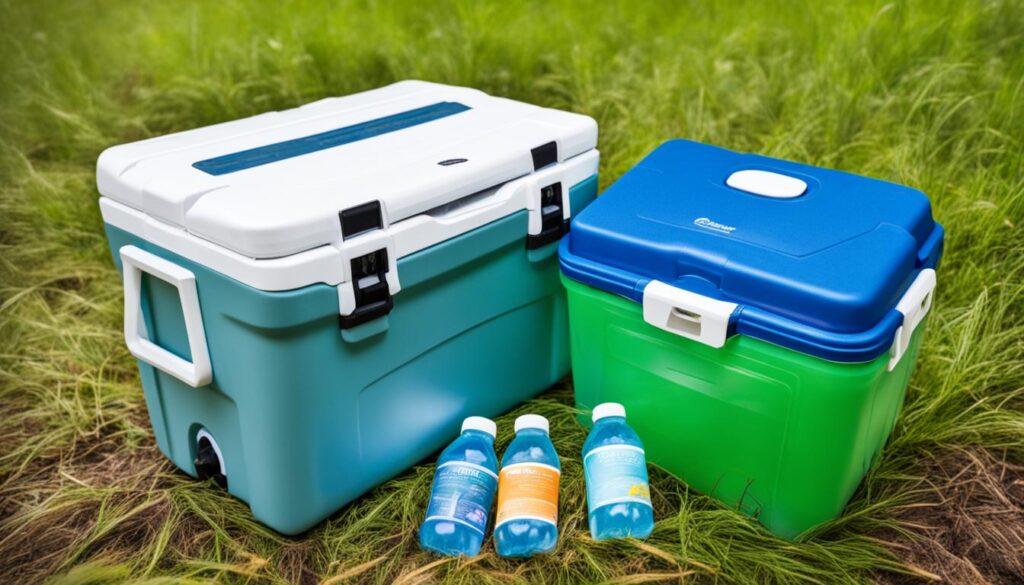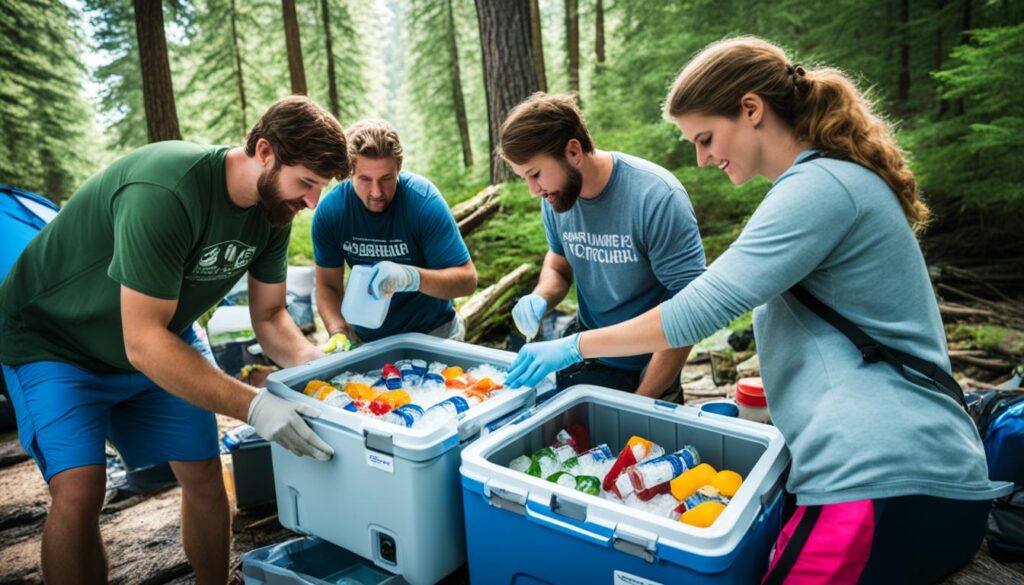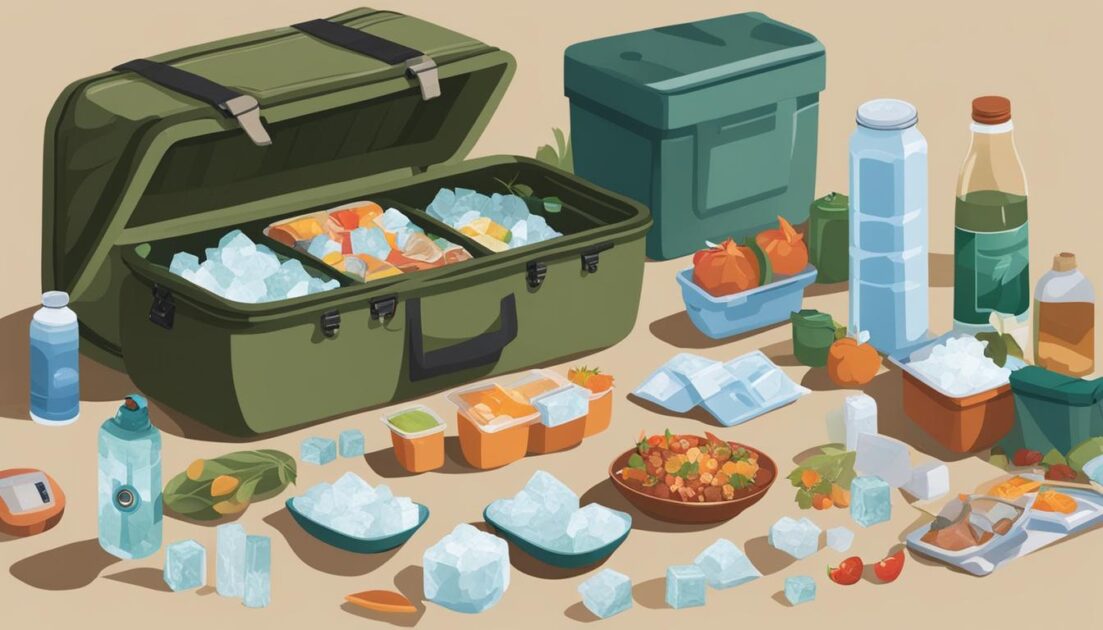When camping, it’s essential to know how to keep food cold to ensure fresh meals and prevent food spoilage. The last thing you want is for your supplies to go bad before you even have a chance to enjoy them. With the right techniques and equipment, you can effectively store your food during your camping trip.
From investing in a high-quality cooler to strategically packing your food, here are some essential tips to help you keep your food cold while camping.
Key Takeaways:
- Invest in a high-quality cooler with thick insulated walls to keep your food cold during your camping trip.
- Use freeze packs or frozen bottles of water instead of traditional ice cubes to maximize cooling efficiency.
- Strategically pack your cooler by placing perishable items at the bottom and non-perishable items on top.
- Keep your cooler shaded and closed to prevent sunlight and warm air from entering.
- Freeze foods in advance and practice food safety measures to ensure freshness and prevent foodborne illnesses.
Invest in a High-Quality Cooler
When it comes to keeping your food cold while camping, investing in a high-quality cooler is essential. Brands like Yeti and Coleman offer top-of-the-line coolers that are designed to keep your food fresh and cold for an extended period of time. These coolers are constructed with thick insulated walls, which provide excellent insulation and help maintain a consistently low temperature inside.
Choosing the right cooler for your camping needs involves considering factors such as size and durability. If you’re planning a longer camping trip or have a larger group to feed, opting for a larger cooler might be beneficial. On the other hand, if you have limited space or are looking for a more portable option, a smaller cooler might be a better fit. Durability is another important consideration, as you’ll want a cooler that can withstand rugged outdoor conditions.
By investing in a high-quality cooler, you can have peace of mind knowing that your food will stay cold and fresh throughout your camping adventure. Whether you’re keeping perishables or beverages chilled, a reliable cooler is an essential camping companion.

Key Features of a High-Quality Cooler:
- Durable construction to withstand outdoor conditions
- Thick insulated walls for optimal temperature retention
- Efficient sealing mechanism to prevent air leakage
- Sturdy handles or straps for easy transportation
- Leak-proof and easy-to-clean interior
- Additional features like built-in cup holders or cutting boards for added convenience
Investing in a high-quality cooler is a smart decision for any camping enthusiast. Not only will it help you keep your food cold and fresh, but it will also make your overall camping experience more enjoyable. So, choose a reliable cooler that suits your needs and embark on your camping adventures without worrying about spoiled food or warm beverages.
Use Freeze Packs or Frozen Bottles of Water
When it comes to keeping your food cold while camping, traditional ice cubes may not always be the most effective solution. Instead, consider using freeze packs or frozen bottles of water to maintain the low temperature in your cooler. These alternatives offer several advantages over regular ice cubes.
Firstly, freeze packs and frozen water bottles are reusable, making them a convenient and cost-effective choice for camping trips. Unlike ice cubes that melt and require frequent replacement, freeze packs and frozen water bottles can be refrozen and reused multiple times, saving you the hassle of constantly buying new ice.
Secondly, freeze packs and frozen water bottles have the added benefit of staying cold for a longer duration. This is because they have a larger mass compared to individual ice cubes, allowing them to retain their low temperature for an extended period. This is particularly useful for longer camping trips or outings where you need your food to remain chilled for several days.
Furthermore, freeze packs are made from non-hazardous materials that are safe for storing food. They are designed specifically for cooling purposes and are usually filled with gel or a similar substance that remains cold when frozen. These packs can keep your food cold for up to 48 hours, providing peace of mind and ensuring the safety of your perishable items.
Using Frozen Bottles of Water
In addition to freeze packs, frozen bottles of water can also be a great alternative for keeping your food cold while camping. Simply fill up plastic water bottles and freeze them prior to your trip. These frozen water bottles serve a dual purpose: they keep your food chilled, and as they melt, you’ll have cold drinking water available without the mess of melting ice cubes.
When packing your cooler, place the freeze packs or frozen water bottles alongside the food items to ensure maximum cooling. Remember to separate them from any open containers to prevent any potential leakage that could compromise the hygiene and safety of your food.
Comparison of Ice Cubes, Freeze Packs, and Frozen Water Bottles
| Feature | Ice Cubes | Freeze Packs | Frozen Water Bottles |
|---|---|---|---|
| Reusability | No | Yes | Yes |
| Durability | Short-lived | Long-lasting | Long-lasting |
| Cooling Duration | Short | Extended | Extended |
| Food Safety | N/A | Non-hazardous materials | Non-hazardous materials |
As the table illustrates, freeze packs and frozen water bottles outperform traditional ice cubes in terms of reusability, durability, and cooling duration. They offer a practical and efficient way to keep your food cold while camping, ensuring that your meals remain fresh and safe.

Pack Your Cooler Strategically
When it comes to keeping perishable food safe while camping, packing your cooler strategically is key. By organizing your cooler in a thoughtful manner, you can optimize its efficiency and ensure that your food stays fresh throughout your camping trip.
Layering Technique
One effective technique is to use the layering method. Start by placing perishable items like meat and dairy at the bottom of the cooler, as this area tends to be the coldest. By keeping these items close to the ice or freeze packs, you can maintain a lower temperature, reducing the risk of spoilage.
Next, layer non-perishable items like snacks, fruits, and vegetables on top of the perishable items. Make sure these items are properly sealed and placed in airtight containers to prevent any cross-contamination.
Reserve the Top Layer
The top layer of your cooler should be reserved for frequently accessed items like drinks and condiments. This way, you can minimize the opening of the cooler, which helps maintain the cold temperature inside. Consider using a separate smaller cooler or a designated section within your cooler for drinks, so you can easily access them without disturbing the rest of the contents.
Additionally, pack your cooler as tightly as possible to prevent any air gaps. This will help to maintain the cool temperature for a longer period. Use towels or packing paper to fill any empty spaces and ensure that the contents are secure and well insulated.
Cooler Packing Checklist
| Perishable Items | Non-Perishable Items | Top Layer |
|---|---|---|
| Meats | Snacks | Drinks |
| Dairy | Fruits and Vegetables | Condiments |
Follow these packing tips to ensure that your cooler is organized efficiently and your perishable food stays safe throughout your camping adventure. With a well-packed and strategically arranged cooler, you can enjoy fresh and delicious meals even in the great outdoors.

Keep Your Cooler Shaded and Closed
To maximize the cooling efficiency of your cooler during your camping trip, it’s important to keep it in the shade as much as possible. Direct sunlight can cause the ice inside to melt faster and increase the temperature, potentially leading to food spoilage.
When setting up your campsite, look for a shaded area where you can place your cooler. This could be under a tree, a canopy, or even inside your tent if space allows. By keeping your cooler away from direct sunlight, you can maintain a lower temperature inside, helping to keep your food fresh for longer.
Additionally, be mindful of how often you open the cooler. Every time you open the lid, warm air enters while cold air escapes, causing the temperature inside to rise. To minimize heat transfer, make sure to retrieve everything you need from the cooler in one go, rather than repeatedly opening and closing it. This will help to keep the inside of the cooler cool for a longer period.
Remember, the goal is to create a protective barrier between the cold temperature inside the cooler and the warmer outdoor environment. By keeping your cooler shaded and limiting its exposure to warm air, you can effectively prolong the lifespan of your ice and keep your food cool without the need for a refrigerator.
Comparison of Cooling Efficiency
| Cooling Method | Advantages | Disadvantages |
|---|---|---|
| Shaded Cooler | – Maintains lower temperature inside – Prolongs ice lifespan |
– Limited shade availability – Requires monitoring of cooler positioning |
| Open Cooler | – Quick and easy access to items | – Increases temperature inside cooler – Accelerates ice melt |
| Cooler in Direct Sunlight | – None | – Causes rapid ice melt – Increases food spoilage risk |
As witnessed in the table above, keeping your cooler shaded offers several advantages over other cooling methods. By maintaining a lower temperature, your food stays cool and fresh for a longer duration. However, it’s important to note that availability of shade may vary depending on campsite conditions. When planning your camping trip, consider selecting a shaded campsite or bringing additional shade options, such as a portable canopy or umbrella, to ensure optimal cooling efficiency.
Freeze Foods in Advance and Practice Food Safety
When preparing for your camping trip, one smart camping food preservation hack is to freeze your food in advance. Freezing food not only helps to prolong its freshness but also keeps it cold in the cooler for a longer time. Make sure to use freezer-safe containers to store items like cracked eggs or pre-prepared meals, ensuring they stay intact and safe during transportation.
Another important aspect of camping food safety is preventing cross-contamination. To do this, it’s recommended to double-wrap frozen meat before placing it in the cooler. This extra layer of protection helps to avoid any potential leakage and keeps your food safe from any bacteria or contamination.
Monitoring the temperature inside your cooler is crucial for maintaining food safety. Use a hanging thermometer to regularly check that the temperature stays below 40°F. This ensures that perishable items are stored at the right temperature, minimizing the risk of bacteria growth and food spoilage.
By utilizing these camping food preservation hacks and practicing food safety measures, you can enjoy fresh and safe meals throughout your camping adventure.
FAQ
How can I keep my food cold while camping?
One of the best ways to keep your food cold while camping is to invest in a high-quality cooler. Additionally, using freeze packs or frozen bottles of water can help maintain the cold temperature inside the cooler. Packing your cooler strategically and keeping it shaded and closed can further enhance the cooling efficiency. Lastly, freezing food in advance and practicing food safety measures can help preserve the freshness of your meals.
What should I look for in a camping cooler?
When choosing a camping cooler, consider the size and durability that best suits your needs. Brands like Yeti and Coleman offer coolers with thick insulated walls that can keep ice frozen for several days.
Can I use freeze packs instead of ice cubes?
Yes, using freeze packs or frozen bottles of water in your cooler is an excellent alternative to traditional ice cubes. These options are reusable and can stay cold for a longer time. Freeze packs, made from non-hazardous materials, can keep food cold for up to 48 hours.
How should I pack my cooler to keep food cold?
To pack your cooler strategically, place perishable items like meat and dairy at the bottom where it’s coldest. Pack non-perishable items like snacks on top. This minimizes the opening of the cooler, helping to maintain the cold temperature inside.
Why is it important to keep my cooler shaded and closed?
Keeping your cooler in the shade as much as possible and minimizing its opening is crucial in preventing the ice from melting faster and the temperature inside from rising.
How can I ensure food safety while camping?
To ensure food safety while camping, freeze food in advance to prolong its freshness. Use freezer-safe containers for cracked eggs or pre-prepared meals and double-wrap frozen meat to prevent cross-contamination. It’s also recommended to use a hanging thermometer to monitor the temperature inside the cooler and ensure it does not exceed 40°F.

